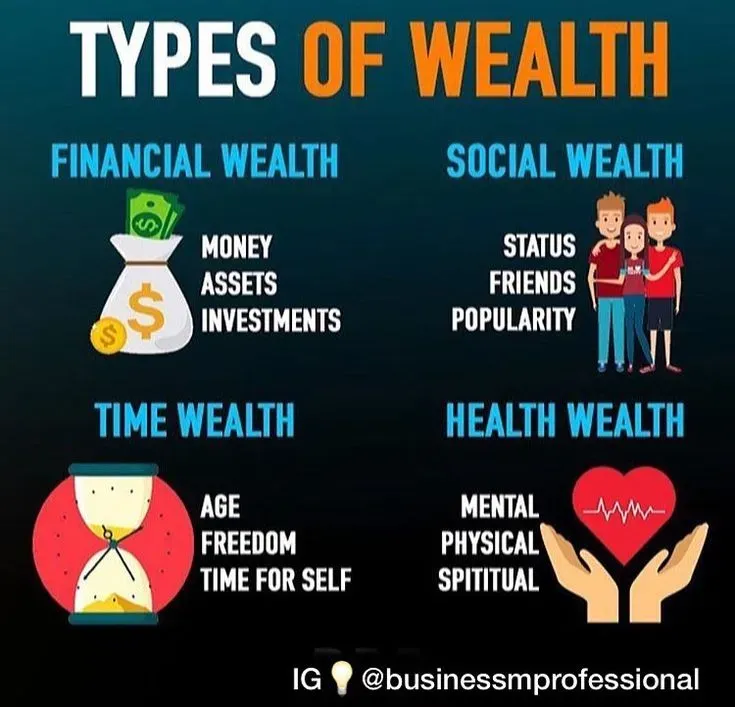When discussing types of wealth, it’s crucial to understand that true wealth extends far beyond the confines of financial resources. Sahil Bloom, in his inspiring work “The 5 Types of Wealth,” shares his journey from traditional measures of success to a richer, more fulfilling view of life. He articulates a distinction between wealth and money, emphasizing that holistic success encompasses time, health, relationships, and happiness, alongside financial stability. This perspective invites readers to explore what genuine wealth means in their own lives, urging a reevaluation of priorities and values. In a world often obsessed with monetary accumulation, Bloom’s insights challenge us to seek balance and fulfillment across all aspects of our existence.
Exploring the concept of wealth reveals a spectrum of abundance that transcends mere financial gain. In his discourse, Sahil Bloom highlights various dimensions of prosperity, including emotional richness, social connections, and personal well-being, all of which contribute to a holistic approach to achieving success. Beyond just wealth in the traditional sense, we must consider the significance of mental health and meaningful relationships when defining a truly prosperous life. By understanding this broader perspective on wealth, we can better navigate our paths toward finding happiness and fulfillment. Ultimately, recognizing the interconnectedness of these elements helps us foster a more profound and satisfying existence.
Understanding the 5 Types of Wealth
Sahil Bloom’s ‘The 5 Types of Wealth’ presents a compelling framework for understanding the diverse elements that contribute to a fulfilling life. Most people are conditioned to equate success with financial prosperity; however, Bloom emphasizes that true wealth encompasses much more. It explores various dimensions including emotional stability, social capital, time freedom, and physical health. By recognizing these factors as components of wealth, individuals can begin to redefine their pursuits and prioritize what genuinely contributes to fulfillment.
This multi-dimensional view of wealth challenges the traditional notion that money is the sole arbiter of success. For instance, Bloom’s own journey showcases his realization that despite professional accolades, he felt unfulfilled. By broadening the definition of wealth, readers are encouraged to assess their own lives, evaluating whether their current trajectories align with their values and what constitutes meaningful success.
Wealth vs Money: Redefining Success
The distinction between wealth and money is crucial in Sahil Bloom’s philosophy. While money is merely a tool—an exchange medium for goods and services—wealth encompasses the richness of experiences and relationships in life. Bloom’s insights push readers to reflect on how often they conflate the two, potentially missing out on aspects of life that foster genuine happiness. In seeking money, it’s easy to overlook the value of time spent with loved ones or the importance of personal well-being.
In a society that often praises monetary gain, Bloom’s work encourages individuals to seek balance between accumulating possessions and nurturing those elements that contribute to holistic success. By examining personal definitions of wealth, one can embark on a transformative journey, prioritizing emotional health, community connections, and overall life satisfaction over mere financial figures.
The Role of Time in Achieving True Wealth
One of the lesser-discussed, yet profoundly significant aspects of the wealth equation is time. Bloom emphasizes that time is indeed a form of wealth that is irreplaceable and often taken for granted. In our hustle-driven world, people frequently prioritize work commitments over personal enrichment and relaxation. This imbalance can lead to burnout and dissatisfaction, detracting from what it means to live a wealthy life.
By vocalizing the importance of time, Bloom invites readers to consider how they allocate their hours. The ability to spend more time with family, pursue hobbies, and engage in self-care activities contributes significantly to holistic success. Time, in this sense, may even outweigh monetary pursuits, as it fosters deeper connections and a more profound sense of joy in day-to-day living.
Social Connections as a Pillar of Wealth
Another crucial dimension of Sahil Bloom’s wealth framework is the importance of social connections. Meaningful relationships can enhance one’s life through emotional support, shared experiences, and networks that provide opportunities. In Bloom’s book, he highlights how wealth isn’t just about financial assets but also the richness brought by friendships and family ties that contribute to emotional well-being.
The cultivation of robust social ties often yields priceless dividends, including enhanced happiness and resilience during tough times. By investing in our relationships, we not only enrich our lives but also create a tapestry of support that sustains us through various life stages. Bloom’s insights remind us that surrounding ourselves with a quality community is a vital component in achieving true wealth.
The Mental Health Component of Wealth
As part of his multi-dimensional view of wealth, Sahil Bloom addresses mental health’s critical role in achieving a fulfilling life. In an era where many face heightened anxiety and stress, the pursuit of psychological well-being is paramount to realizing what true wealth means. Bloom suggests that mental health can impact every other aspect of wealth, including financial decisions, relationships, and personal fulfillment.
Fostering a healthy mindset often involves prioritizing self-reflection and mindfulness practices. By promoting mental wellness, individuals can enhance their capacity to pursue not only careers that align with their passions but also cultivate personal relationships and experiences that contribute to happiness. Bloom’s focus on mental health serves as a reminder that a balanced approach to wealth significantly enhances one’s overall quality of life.
Finding Happiness Beyond Financial Gain
One of the standout messages of Sahil Bloom’s book is the emphasis on finding happiness that transcends financial gain. Bloom encourages readers to contemplate what truly brings joy into their lives, often discovering that it isn’t always tied to income or material possessions. By prioritizing experiences, health, and relationships, individuals can step away from the conventional chase for money and instead invest in elements that yield lasting satisfaction.
This shift in focus can be transformative, asserting that the relentless pursuit of wealth may require reassessment. Engaging in activities that bring joy, such as volunteering, pursuing hobbies, or spending time with loved ones, can lead to a richer and more rewarding life. Ultimately, Bloom’s insights guide readers toward a path where happiness is defined by personal fulfillment rather than financial status.
Insights from Influential Figures
‘The 5 Types of Wealth’ has garnered commendation from notable figures, illustrating its profound impact on a broader audience. Tim Cook, for instance, praises Bloom’s approach as prompting essential introspection on life’s guiding principles. This endorsement from a leader in the tech field highlights the relevance of Bloom’s insights on wealth and happiness in various sectors, encouraging individuals from all backgrounds to reflect on their life choices.
Additionally, voices like Mel Robbins and Bill Ackman underline the book’s power to provoke thought about what constitutes success. Their recognition adds significant weight to Bloom’s philosophy, suggesting that even the financially successful can benefit from reevaluating their own definitions of wealth. This collective affirmation showcases the potential for positive societal shifts towards holistic success.
Challenging Conventional Beliefs Around Wealth
Sahil Bloom’s narrative flips the script on commonly held beliefs about what it means to be wealthy. He posits that most people are misled into believing that monetary success equates to overall happiness. This common narrative is challenged throughout his book, inviting readers to question societal norms and consider alternative views that encompass a broader perspective of wealth.
By addressing these conventional beliefs, Bloom encourages individuals to clarify their values and approach to life. It can be enlightening to realize that wealth can be intrinsically linked to time, relationships, and personal health rather than just material accumulation. The transition from viewing success through a narrow lens to a more inclusive understanding can lead to deeper fulfillment.
The Balance Between Pursuing Wealth and Happiness
Finding the balance between pursuing financial wealth and ensuring personal happiness is a central theme in Sahil Bloom’s teachings. In modern society, many feel pressured to prioritize their careers and earnings, often at the expense of happiness and well-being. Bloom advocates for a conscious approach where individuals can chase their goals without compromising their health and relationships.
Striking this balance requires self-awareness and intentionality. By fostering habits that nurture both external achievements and internal satisfaction, individuals can redefine success on their terms. Bloom’s guidance aims at helping readers navigate this delicate balancing act, ultimately leading to a richer, more fulfilling experience in life.
Frequently Asked Questions
What are the different types of wealth outlined by Sahil Bloom?
Sahil Bloom identifies five key types of wealth: financial wealth, time wealth, social wealth, mental wealth, and physical wealth. This holistic view emphasizes that true wealth transcends just financial resources, incorporating aspects like personal fulfillment, relationships, and well-being.
How does Sahil Bloom define true wealth compared to money?
Sahil Bloom defines true wealth as a multifaceted concept that encompasses more than just money. While financial wealth is an important aspect, true wealth includes emotional, social, and physical dimensions that contribute to overall happiness and fulfillment in life.
What is the significance of wealth vs money in achieving holistic success?
The concept of wealth vs money is crucial in pursuing holistic success. Sahil Bloom argues that focusing solely on monetary gain can lead to neglecting other vital aspects of life such as relationships and mental health, which are key to experiencing true wealth and a fulfilling life.
How can understanding the types of wealth lead to finding happiness?
Understanding the various types of wealth can help individuals prioritize what brings them joy and satisfaction. By recognizing that true wealth includes time, relationships, and health, as highlighted by Sahil Bloom, one can make deliberate choices that align more closely with their values and happiness.
Why is a holistic approach important in the discussion of wealth?
A holistic approach, as advocated by Sahil Bloom, is important because it challenges the narrow definition of wealth that often equates it with financial success. By considering emotional, physical, and social well-being alongside financial resources, individuals can work towards a balanced and fulfilling life.
What lessons can billionaires learn from Sahil Bloom’s views on wealth vs money?
Billionaires, like Tim Cook and others who praise Sahil Bloom’s insights, can learn that the relentless pursuit of money may overlook essential life dimensions such as relationships and personal happiness. Bloom’s perspectives promote introspection on what true wealth means beyond financial status.
In what ways did Sahil Bloom’s journey reshape his understanding of wealth?
Sahil Bloom’s journey reshaped his understanding of wealth by illustrating that despite having financial success, true fulfillment comes from balancing life’s various dimensions. He realized the importance of personal values and connections over mere financial accumulation, redefining what success means.
How does Sahil Bloom’s book inspire reflection on wealth and happiness?
Sahil Bloom’s book inspires reflection on wealth and happiness by encouraging readers to evaluate their life priorities. It challenges conventional views that equate success with financial gains and promotes a deeper understanding of what constitutes true wealth in achieving overall fulfillment.
| Aspect | Description |
|---|---|
| Financial Wealth | Traditional concept of wealth measured by income, assets, and financial success. |
| Time Wealth | Having control over one’s time to pursue passions and interests beyond work. |
| Social Wealth | Building valuable relationships and connections that enhance life quality. |
| Mental Wealth | Maintaining a healthy mindset, emotional stability, and a positive outlook. |
| Physical Wealth | Prioritizing health and physical well-being as foundational to overall happiness. |
Summary
The types of wealth extend far beyond mere financial assets to encompass various dimensions of life that contribute to overall happiness and fulfillment. Sahil Bloom’s insights challenge the traditional notion of wealth by illustrating that true prosperity includes time, social connections, mental health, and physical well-being. By advocating for a holistic approach, Bloom emphasizes that a balanced life enriched in multiple areas ultimately yields greater satisfaction than simply accumulating money. This perspective encourages readers to reflect on their own definitions of success, leading to a more comprehensive understanding of what it means to live a wealthy life.








